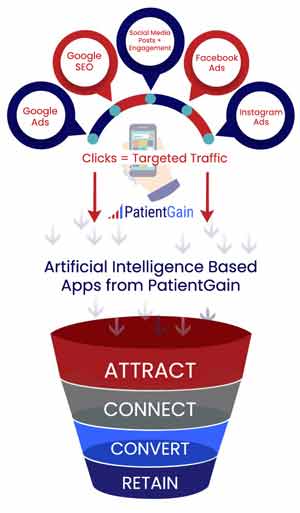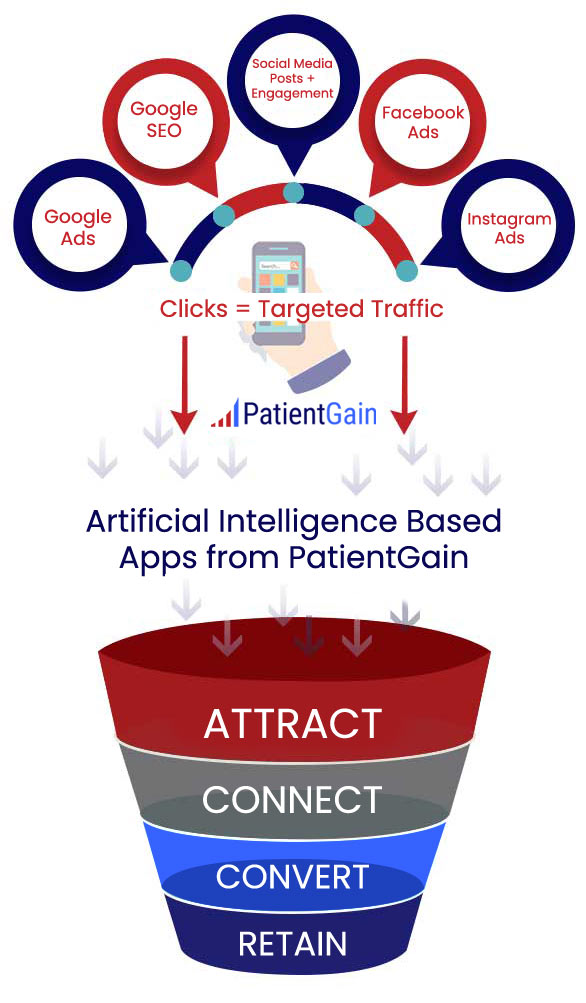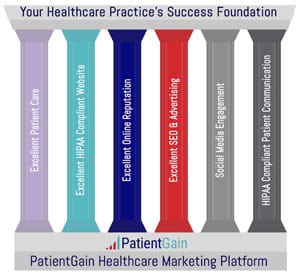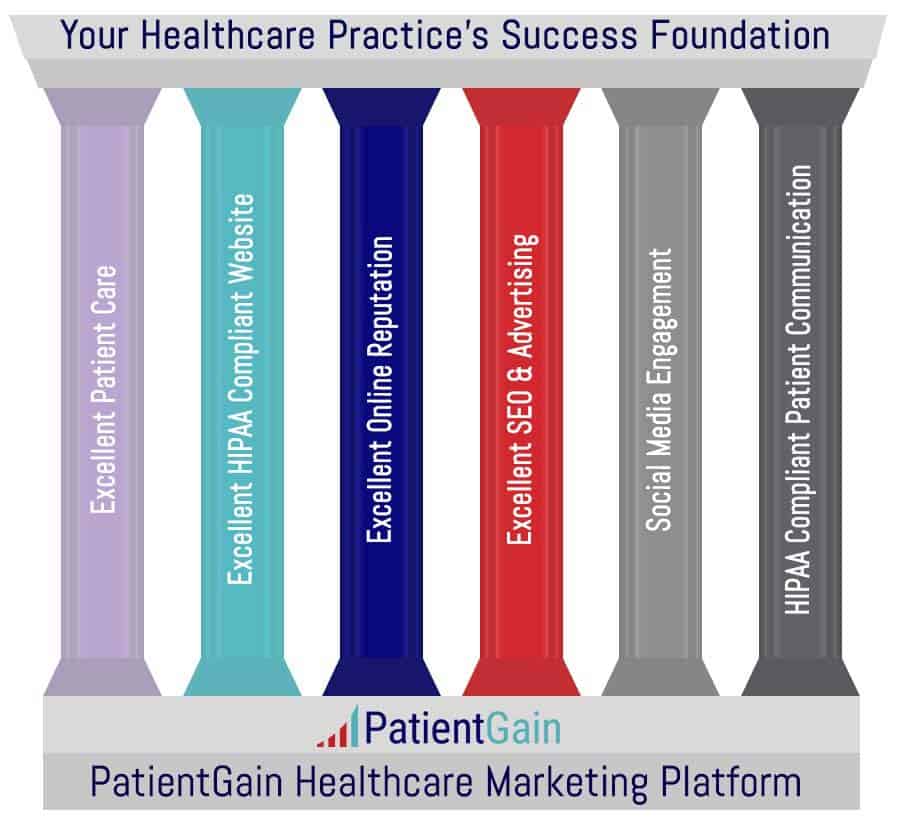What Is Dental SEM – Search Engine Marketing or Paid Ads for Dental Practices?
Regardless of whether it has just celebrated its grand opening or a ten-year anniversary, a dental practice will need to need to engage in search engine marketing. Also known as SEM, this marketing strategy is widely used by other dental practices and others in the health care profession. When combined with different marketing strategies, it can be very effective and enhance an overall dental marketing plan. The team at PatientGain.com have experts who have years of experience in helping dental practices navigate search engine marketing. Below are some concepts about SEM that all dental practice owners should know.
Is there a difference between search engine marketing and search engine optimization? Are SEM and SEO interchangeable?
Although some may switch these terms, SEM and SEO are not the same things. SEO, or search engine optimization, is an element of SEM, or search engine marketing. SEM uses both paid and organic results to promote a dental practice’s website. The other part of SEM, other than SEO, are pay-per-click ads or PPC ads. These two elements of SEM often work together to enhance the effectiveness of each other. SEO involves improving a website using keywords to appear in the organic results of a search query. PPC ads involve selecting target keywords to bid on so that a website will appear in a paid result. SEO improvements will often make PPC campaigns more effective. For example, bidding on a target keyword for a search engine marketing campaign is much easier if that word frequently appears on a dental website. If a dental practice wants ads to show up for root canals when people search for them, it is easier to win that bid if that keyword appears in the content. Some dental practices may start to ignore PPC campaigns once their SEO work begins to show results. This would be a mistake for them to do this. First, it allows competitors more room to advertise, potentially taking patients away from a dental practice. Also, it can be compelling for a potential patient to see a dental practice appear in both paid and organic results. Effective SEM marketing has both an SEO and PPC component working together to attract users to a website.


Is search engine marketing (SEM) the same thing as having paid ads?
Like SEM and SEO, these terms do not have interchangeability. Paid ads, be it Pay Per Click or Display ads, are a part of the overall umbrella of search engine marketing. It occupies one side, while search engine optimization occupies the other side. SEM should be seen as the overall marketing strategy, while paid ads are a part of that strategy.
How can SEM benefit a dental practice?
A well-put-together SEM campaign will drive potential patients to a website that will hopefully turn into patients. No matter how well-written a website is or the state-of-the-art facility a dental practice may have, it will not be beneficial if people do not know about it. Today’s vast majority of people seeking dental care will start their patient journey by researching their options online with a search engine. Effective SEM marketing will have a dental practice’s website appear in both paid ads and organic results. The more often it appears in search results, the chances and likelihood will increase that a potential patient will click on it, explore the site, and become a patient.
Another benefit to SEM marketing is that it covers a lot of ground for search engines. When organic ranking is not where it needs to be, paid ads can send traffic to a website. When organic ranking is looking good, paid ads can continue to send traffic to the website but at a reduced budget. As mentioned, however, both need to be active and operating together to be genuinely effective.
How do paid ads benefit a dental practice?
When a dental practice has first opened or is just starting to offer a new service, it is unlikely to have much in organic ranking. A search engine does not have enough information about a dental practice when a new site is launch, or a new content page is published to determine if it is relevant enough for organic results. While a dental practice waits for a page or website to build organic rankings, paid ads can fill that gap and send potential patients to visit. The resulting increased web traffic will help search engines see that the site is relevant to paid results and organic results.
However, ads are only beneficial if they are set up correctly for a dental practice. Many make mistakes by are sending website visitors to the home page regardless of what the paid ad says. This can decrease conversion rates and make a search engine think that a dental practice’s website is irrelevant for keywords. Instead, a dental practice would be wise to match the content with the copy of the ad. For example, if a paid ad is advertising root canals, that click should send a potential patient to the root canal service page. If the ad talks about pediatric dentistry services, then it should send people to that service page. While it does take a little longer to set up, this will help maintain the attention of potential patients and make ads much more effective.
Are there any pros and cons to search engine marketing?
Like any marketing strategy or tactic, SEM or search engine marketing has some pros and cons. Below are some of the biggest pros and cons of SEM.
The Pros of Search Engine Marketing For Dental Practices
Reaching More Potential Patients Online – The most significant pro of using SEM is boosting the paid and organic ranking of a dental practice’s website, therefore reaching more people. The paid aspect of SEM depends on a budget, and the organic element depends on the search keywords selected. Both can have tremendous impacts if coordinated correctly or none if a dental practice is not carefully managing them.
Improve The Bounce Rates of a Dental Practice’s Website – In digital marketing, a bounce is when someone quickly visits a website and then leaves to view other sites. The percentage of website visitors who do that is known as the “Bounce Rate.” Typically, a bounce occurs when someone mistakenly visits a website or quickly evaluates it as not what they were looking for. Bounce rates impact the cost of paid ads a well as organic ranking. The longer website visitors spend time on a website, the lower the bounce rate. Bounce rates play a role in organic rankings and make paid ads more effective. A higher bounce rate will make a site look less relevant and authoritative for target keywords to search engines.
Helps Push The Brand Identity of A Dental Practice
The more often a dental practice appears in search results, the more people associate it with dental keywords. This will only help expand the brand identity of a dental practice in the community with their target audience. Compared to offline and traditional marketing, it is much more cost-effective to push a brand over search engines than advertising in newspapers or radio ads. The more often a site appears as a top search result, the higher the brand value to a search engine. Increased brand value only reinforces high rankings in the eyes of a search engine and will drive more patients to the website.
SEM Marketing Often Benefits Small & Locals Businesses
Small and local businesses can take advantage of SEM marketing as their smaller footprint in terms of a target audience is harder to dislodge if a national or regional dental practice brand moves into the area. Local and small dental practices have an established “territory” of the target audience for new patients and, if SEM is deployed correctly, will be very relevant to those target audiences. The majority of people looking for dental practices or any other business for that matter will want a local, relevant result. SEM marketing helps a search engine understand that a dental practice is a tremendous local result for those searching for dental health services. Applying SEM tactics to a dental website will make it stand out among competitors that do not.
The Cons of Search Engine Marketing For Dental Practices
Search Engine Marketing is Time Consuming
All aspects of SEM, but PPC and SEO, are time-consuming to be done correctly. A lot of time needs to be put into the planning, implementation, and management of SEM. No part of search engine marketing is a “one and done” proposition. All aspects need to be monitored, improved, and sometimes changed to maintain peak performance. Updates are frequent as keywords can change as well as the search engine algorithm. Tactics used today for PPC and SEO to make an SEM plan shine could be useless a few years from now. A dental practice needs to stay on top of trends so that its SEM will perform well. All of these factors make it very time-consuming.
SEM Can Be Expensive
SEM can be costly in several ways. First, and most obvious, is the PPC budget you choose to promote a dental practice. Spend too little, and there will be no impact. Spend too much, and other marketing campaigns will not have the funding they need to be effective. The SEO aspect of SEM also takes time to start to get traction, which means it will take time to generate a return in the time and money put into it. Outsourcing an SEM campaign to a third party must be done carefully. PatientGain.com, unlike other SEM companies, will show proof of past work with different clients to prove the effectiveness of our SEM work. Some small businesses may find effective SEM work to be too expensive.
If implemented incorrectly, SEM can cause search engine penalties to websites.
Search engine rankings and paid ads are not the Wild West of the internet. A website must abide by specific rules and standards or find its site suppressed in search results. Trying to cheat or game the system using unethical SEM tactics to get a shortcut to the top of organic rankings will not work. Search engine algorithms are very good at picking up on those tactics and have seen them before. If a site uses too many of them and blatantly tries to cheat to get at the top of search results, a search engine may permanently penalize a site, exiling it from search results altogether.
How is ROI Calculated for dental advertising on google ads?
ROI, or Return on Investment, is a ratio that compares the net profit to advertising costs. It is a crucial metric to follow because it is used to evaluate the effectiveness of advertising campaigns. A bad ROI may indicate it is time to change something, while a good ROI may show that more budget should be put into the campaign. There are a few ways to calculate ROI depending on the goal of a dental practice. However, below is one way ROI could be calculated for a dental practice.
Dental Marketing Return On Investment (ROI) Formula
(Total revenue generated Minus $ spend on campaign ) Divided by $ spent on a a campaign

Assuming in this example, the dental practice spends $2795 per month on dental marketing.


